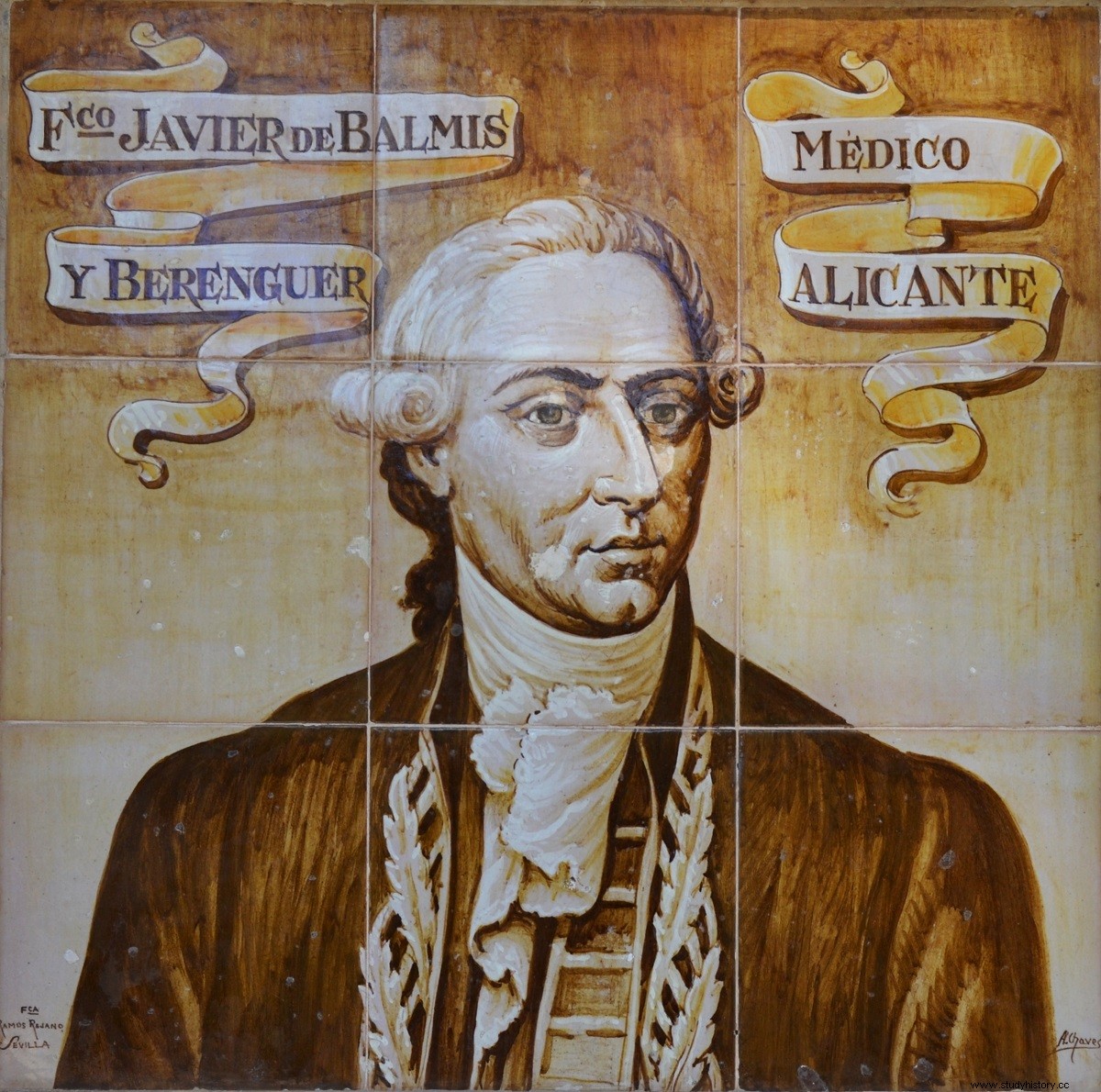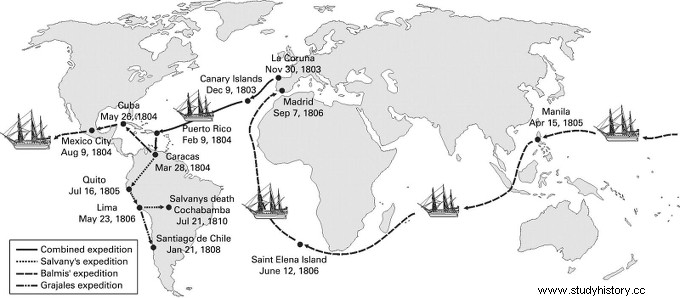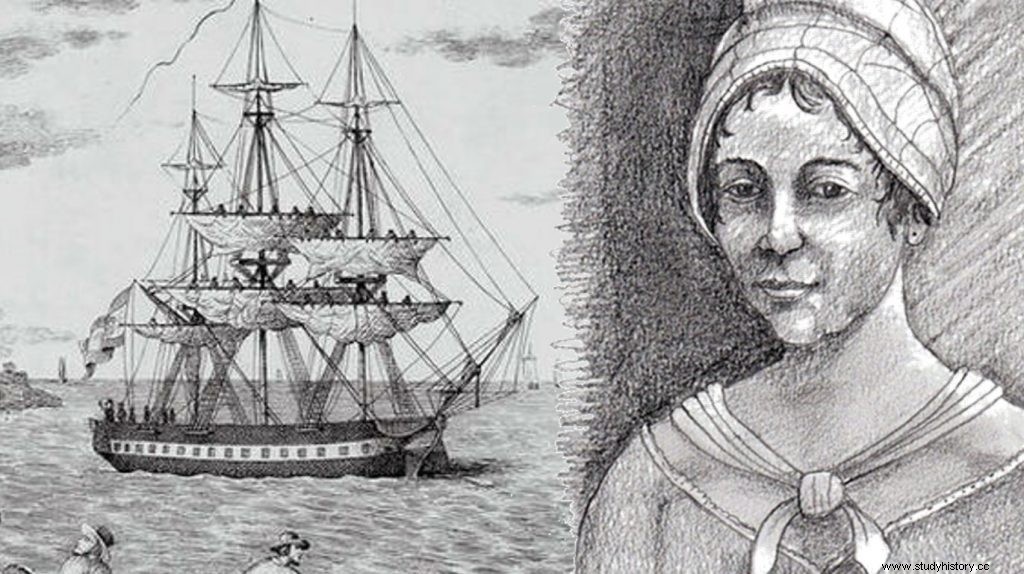The greatest example of philanthropy in history is not a rabbit that has pulled me out of the hat, but the words of Edward Jenner , the doctor who discovered the vaccine.
«I cannot imagine that in the annals of history there will be an example of philanthropy as noble and great as this in the future
And something like that was the opinion of the German naturalist and explorer Alexander von Humboldt , considered the father of modern Geography:
The trip will remain the most memorable in the annals of history.
This is the story of that trip. At the beginning of the 19th century, news arrived from America of a great smallpox epidemic, and the King of Spain, Carlos IV, ordered that projects be drawn up to bring the vaccine to the new continent. In short periods of time, the liquid from the pustules, which contains the virus, could be kept and moved between crystals and sealed with paraffin, but here we are talking about a transoceanic trip of almost two months, so we had to think of a method alternative that kept the virus "alive" for so long. Several projects were presented and, after the opportune deliberation of the pros and cons, the doctor Francisco Xavier Balmis was chosen. , which consisted of moving the fluid from arm to arm through a human chain of children. On June 5, 1803, Carlos IV signed the Order of the Royal Philanthropic Expedition of the Vaccine to take her to America and financed by the Crown. The objectives of such a company were three:
- Take the vaccine from Spain to all overseas territories (not only to the American continent).
- Instruct local doctors in the populations visited to continue vaccination over time.
- Create "Vaccination Boards" in the different territories as centers to conserve, produce and supply active vaccines to maintain the campaign permanently.

At the head of this expedition of nurses, interns and other assistants, were the doctors Francisco Xavier Balmis and that of him second to him José Salvany . To carry out this titanic undertaking, I would need to "recruit" children -there are fewer chances of having been exposed to smallpox than an adult-, who were healthy, between the ages of 6 and 9 and who had not had "natural" smallpox or they had been vaccinated. Two children would be vaccinated who, over a week or so, would develop the characteristic pustules of cowpox, the liquid with the live virus would be extracted from them, and two other children would be vaccinated. And so on until you reach your destination. The children acted as true reservoirs, which is why they were called the vacciniferous children . According to Balmis calculations, to cross the pond, 22 children were going to be needed. And since nobody was going to lend their children for such a task, they thought of those who were under the tutelage of the Crown:the orphans of the hospices (foundlings). It should be pointed out that, despite being a philanthropic expedition and for once in history, the king scratched his pocket and did not give a single but to Balmis' requests, both in personnel and in material.
In the month of September, the entire operation is moved to La Coruña, from where the expedition will depart and where the children will be recruited. And here our protagonist appears, Isabel Zendal (*), Rector of the House of Foundlings of La Coruña. Balmis's first contact with Isabel occurs when the doctor goes to the hospice to recruit the children. After the selection of the 22 children, Isabel asks the director of the expedition that she wants to accompany them and play the role of a mother figure. Something that was not planned. In fact, in the list of names of the members of the expedition that the king approves when they leave Madrid, no woman appears. So, seeing that the children's relationship with Isabel is almost, as she puts it, maternal, she understands that it will be beneficial to have her participation and sent a request to the monarch, which, logically, he approved...
The King agreeing with the proposal of the Director of the expedition destined to propagate the inoculation of the vaccine in the Indies, allows S.M. that the Rector of the House of Foundlings of that city be incorporated in the same expedition in the Nursing class, with the salary and cost assistance indicated to the Nurses, so that she can take care of the assistance and cleaning of the Children who have to embark and cease the repugnance that is experienced in some Parents to entrust their children to the care of those, without the relief of a Woman of providence.
On November 30, 1803, the corvette María Pita departed from the port of La Coruña. with his crew, the members of the humanitarian convoy (Balmis, Salvany and two more surgeons, two interns, three nurses, Isabel and the 22 children), the necessary tools and hundreds of copies of the Historic and practical treatise on the vaccine of Moreau de la Sarthe, translated by Balmis. They arrive in the Canary Islands in January 1804, where they vaccinate the population and establish a vaccination center; to Puerto Rico in February and to the coasts of present-day Venezuela in March. The first Vaccine Board of the continent will be established in Caracas, from where it will be disseminated, preserved and produced, it will be taught to doctors in the area and copies of the treaty will be delivered. This Vaccine Board served as a model for the many that were established throughout the entire expedition.

In Caracas the expedition was divided into two groups:one led by Salvany who set out for the south to bring the vaccine to the territories of South America; and another, under the direction of Balmis himself, who embarked again to reach Havana, return to the continent and travel through Guatemala, Costa Rica... to Mexico. Following the Caracas model, Vaccination Boards were strategically established to cover the largest possible territory. Once the work was done across the pond, in February 1805 the Balmis expedition embarked at the port of Acapulco in the direction of the Philippines. And here, again, it was necessary to pull children who were vaccinated to cross the Pacific and reach Manila. On this occasion there were 26 Mexican children. In April 1805, they arrived in Manila, where another Vaccination Board was established as a dissemination center for the Philippine Islands. Knowing that the vaccine had not reached China, Balmis requested and was granted permission to disembark in Macao, under Portuguese sovereignty, from where he entered Chinese territory. Almost three years later, on September 7, 1806, Balmis arrived in Madrid, where he was received by Carlos IV.
Salvany's expedition was longer in time and more painful. Route Cartagena de Indias, Santa Fe de Bogotá, Quito, Lima and La Paz. In 1810 Salvany died and Manuel Julián Grajales , one of the surgeons, was able to lead and continued to Santiago de Chile and the Chiloé Islands, to complete all of South America with the arrival in Patagonia… in 1812!!!
With all these data, I think it is not unreasonable to say that it is the most important health campaign in all of history:because of the geographical dimension that it encompassed (a trip around the world and touring the American continent), because of the time it lasted, because of the difficulties organization of a company of this magnitude (financing, transoceanic trips, with their storms and the corresponding attacks by pirates; due to the scarce or null collaboration on the part of the local authorities in some places or due to the management of the "reservoirs" -the 26 Mexican children or the three slaves they had to buy for the journey from Caracas to Havana-), and, above all, for mass vaccination, regardless of the social status of each one, which saved millions of lives and, moreover, with the creation of the Vaccination Boards, which constituted the primitive public health network of all these countries.

And what was Elizabeth's role? Well, take care of the children. And when I say childcare I mean in the broadest sense of the word, because in addition to continuing to do the same for them as if they were still in La Coruña, we had to add the setbacks corresponding to a long sea voyage (dizziness and vomiting of children) or the suffocating heat of the tropics, without forgetting the tasks of the mission:be careful that the inoculated children do not mix with the rest, that they do not scratch the pustules or that they are clean and tidy, fundamental for not break the viral chain. Without being a nurse, she acted like a true professional, and without forgetting the signs of affection, something essential for those involuntary protagonists. Balmis, not much given to giving compliments, wrote…
The poor Rector, who with the excessive work and rigor of the different climates that we have visited, lost her health entirely, tirelessly night and day, has poured out all the tenderness of the most sensitive Mother on the 26 little angels that she has in her care, in the same way who did it from La Coruña and on all the trips and has fully assisted them in their continued illnesses.
Isabel accompanied Balmis to the Philippines, but she did not return to Spain with him... or without him. She returned to Mexico and settled with her son, Benito de Ella, one of the children from La Coruña, in Puebla de los Ángeles, where her history is lost. Until now I have not named her son because it is not clear that he was, and if he was, there are two versions:one that was adopted and another that he had had in her marriage with her deceased husband.
(*) About Isabel's first surname there are several versions, even in the writings of Balmis himself she is cited with different patronymics. (Zendal, Cendales, Sendales, Cendal, Cendala, Sandalla...)
